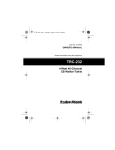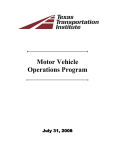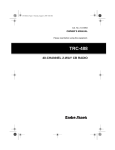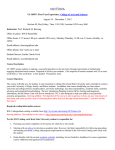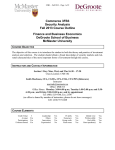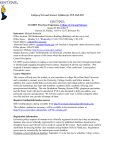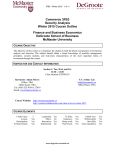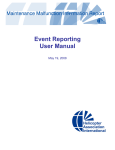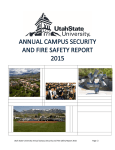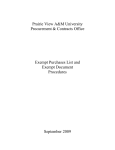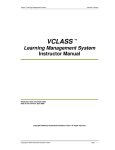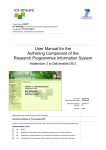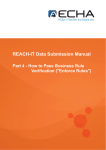Download 311 Business Strategy Tuesday and Thursday: 6:00PM – 9:00PM
Transcript
Texas A&M University - Central Texas GBK 459 – 311 Business Strategy Tuesday and Thursday: 6:00PM – 9:00PM Founders Hall - 411 INSTRUCTOR AND CONTACT INFORMATION Instructor: Office: Phone: Lee Warren Brown, Ph.D. 318B 254-519-5757 If unavailable COBA Department Main Phone Number: 254-519-5437 Email: [email protected] Office Hours: (2nd 8 Weeks Monday 8:30-11:30AM & Tuesday 3:00-6:00) Class Schedule TTh 6:00-9:00 Student-instructor interaction: I will do my best to check the Blackboard message area at least daily during the work week. I also regularly check my TAMUCT e-mail ([email protected]) several times a day during the workweek, and occasionally on weekends. Note that I cannot guarantee immediate replies to student e-mails. However, in most cases I will e-mail responses back within 24 hours unless it is over the weekend or I am out of town. UNILERT Emergency Warning System for Texas A&M University – Central Texas UNILERT is an emergency notification service that gives Texas A&M University-Central Texas the ability to communicate health and safety emergency information quickly via email, text message, and social media. All students are automatically enrolled in UNILERT through their myCT email account. Connect at www.TAMUCT.edu/UNILERT to change where you receive your alerts or to opt out. By staying enrolled in UNILERT, university officials can quickly pass on safety-related information, regardless of your location. COURSE INFORMATION 1.0 Course Overview and description: This is a writing-intensive capstone course involving the integration of concepts and principles studied in accounting, economics, finance, management, marketing, quantitative methods, and other relevant business disciplines. It includes aspects relating to both creative and technical problem solving / business decision making. It is designed to be taken by senior business majors during their last semester, but may be taken earlier if the necessary prerequisites have already been completed (see next section). 2.0 Course Objective: GB 459 is a challenging capstone course that focuses on how firms formulate, implement, evaluate, and present strategies through written case study analysis, presentations and a computer-based business simulation. The course centers on the theme that a company achieves sustained success if and only if its managers (1) have an astute, timely strategic game plan for the company, and (2) implement and execute the plan with proficiency. This course allows students to explore in-depth how and why a well-conceived and well-executed strategy nearly always enhances a company’s long-term performance. This course also gives students the opportunity to integrate much of the knowledge that they have gained in their business curriculum to date – marketing, accounting, management, finance, and so on. This is a “big picture” course. The problems and issues surrounding the tasks of crafting and implementing strategy cover the whole spectrum of business and management. Many variables and situational factors must be dealt with at once. Weighing the pros and cons of one strategic option versus another entails a total enterprise perspective and good judgment about how all of the relevant factors combine to shape what actions need to be taken. Strategy involves the careful consideration of current and past contextual and organizational factors as well as imaginative and prospective consideration of what future alternatives are possible to realize. As such, this course requires students to be somewhat “ambi-brained.” In other words, this course requires the use of both logical/analytic and the visual/creative thinking. Finally, this is a WRITING INTESTIVE (WI) course. WI courses are intended to foster the development of communication skills needed for effective participation in the (business) world. Effective communication (written, verbal and nonverbal) is a highly valued and marketable skill in any field. Surveys have shown that the ability to communicate well is ranked by business executives as first among the personal factors necessary for promotion. This course will focus on continuous improvement in written language. Please note that although this course has an official writing intensive designation, oral communication skills will also be emphasized and evaluated (see details below). Please note that each student must pass the writing component of a WI course in order to pass the course, regardless of his or her performance on all other course components. 2.1 Student Learning Outcomes SPECIFIC COURSE LEARNING OBJECTIVES 1. COURSE INTRODUCTION: In this section of the course, students will demonstrate their understanding of the overall design of the course, the specific course components involved, and the foundational terms upon which the course will build. 1.1. Students will read the contents of this course syllabus. 1.2. Students will identify the necessary elements for completing a case study analysis in this class (in preparation for completing a case study in later course modules) and an individual project. 1.3. Students will identify the terms and procedures from the Participant’s Guide for the Glo-bus™ strategy simulation (in preparation for participation in the simulation). 1.4. Students will define and describe the terms strategy and the strategic management process. 1.6. Students will define and correctly utilize the vision, mission, and values framework. 2. STRATEGIC ANALYSIS (Strategy Module 1): Students will define the terms, describe the frameworks, and engage in the process of strategic analysis. 2.1. Students will define the components of external environment analysis, and conduct an external environment analysis for a real company. 2.1.1. Students will define and describe the components of the general environment, and conduct an analysis of the general environment of a real company. 2.1.2. Students will define and describe the components of the competitive environment, and conduct an analysis of the competitive environment of a real industry. 2.1.3. Students will define and describe the strategic groups framework, and conduct a strategic groups analysis for a real industry. 2.2. Students will define the components of internal environment analysis, and conduct an internal analysis for a real company. 2.2.1. Students will identify the components and distinctive features of the value chain analysis framework, and conduct a value chain analysis of both a firm and an industry. 2.2.2. Students will identify the components and distinctive features of the resource-based view of the firm, and conduct a resource analysis for a real firm. 3. STRATEGIC FORMULATION (Strategy Module 2): Students will identify the principles and processes of formulating strategy, and will formulate a strategy for a real company. 3.1. Students will identify the distinctive features of business-level cost leadership, differentiation, focus, and combination strategies, and create a set of strategic alternatives for a real company based on these strategies. Students will also implement one or more of these strategies as part of a course strategy simulation. 3.2. Students will identify different varieties of corporate diversification and the relative risks and benefits inherent in each. 3.3. Students will identify components of entrepreneurial strategy and competitive dynamics. 4. STRATEGIC IMPLEMENTATION (Strategy Module 3): Students will define the terms and principles of strategic implementation, and will develop a strategic implementation plan for a real company. 4.1. Students will identify types and principles of strategic controls and corporate governance, and demonstrate these principles as part of a strategic implementation plan for a real company. 4.2. Students will identify types and distinctive features of different organization structure types. 4.3. Students will identify the qualities, dimensions, and paradoxes of innovation and the basic principles involved in managing it. 3.0 Required Reading and Textbook(s): Dess, Lumpkin, Eisner, and McNamara (2013). Strategic Management: text and cases, 7th Ed., McGraw-Hill/Irwin, New York ISBN 978-0077862527. Note: students are not under any obligation to purchase their textbooks or other course materials from a university-affiliated bookstore. The above-named textbook may also be available from an independent retailer, including an online retailer or textbook rental service. It is also possible to RENT a textbook, including e-textbooks (which are downloaded as PDFs). www.chegg.com has a nice feature that allows students who have ordered paper copies of their texts (either for purchase or for rent) to read PDF versions of a text for up to 7 days while they wait for their paper copy to arrive by mail. This is especially attractive for 8-week courses, where it is not practicable to wait several days for a text to arrive. COURSE REQUIREMENTS 4.0 Course Requirements: GENERAL BEHAVIORAL OBJECTIVES: In addition to the General and Specific Course Learning Objectives, each student must: Demonstrate PROFESSIONAL INITIATIVE at all times by taking responsibility for one’s own performance in the course, as well as for any opportunities one may be able to take to enhance the course for others. This should be demonstrated vis-à-vis course assignment details, course deadlines (and personal time management, generally), contributions to groupwork, use of required course technology, and the anticipation and competent management of contingencies relating to oneself and to others that may affect one’s performance in the course (e.g., job, family, other courses). Demonstrate PROFESSIONAL COURTESY at all times by maintaining a professional tone in all communication with all persons involved with this course: peers, professor, teaching assistant, etc. This includes any communication that may involve reporting interpersonal conflict, engaging in discussions or disputes, or giving / responding to negative feedback. Professional courtesy also includes a commitment to listening well, and to engaging in meaningful dialogue where other parties are given ample opportunity to contribute to the discussion or assignment at hand without fear of disruption, retribution, or unwarranted criticism. Finally, it also includes common courtesies such as letting group members know in advance if you going to be unavailable for a scheduled meeting, or if you are going to miss an agreed-upon deadline due to an unforeseen disruption. Demonstrate PROFESSIONAL INTEGRITY at all times by complying with all guidelines and restrictions regarding the completion of student work, the use of external sources, and the general compliance with the TAMUCT academic integrity policy, and the giving of specific, accurate, and timely peer performance evaluation. Demonstrate a commitment to PROFESSIONAL DEVELOPMENT at all times by reading, comprehending, integrating, and applying all textbook and other reading materials, audio and video supplements to all course assignments and activities (as measured by exams, cases, simulation, reviews etc.), and by successfully completing all assignments and activities to the best of one’s abilities at the present time. Demonstrate PROFESSIONAL MATURITY at all times by accepting the circumstances under which one has chosen to attempt to complete this course, and by accepting the evaluation of one’s work by one’s peers and/or instructor without complaining or resorting to irrelevant appeals (e.g., “this could hurt my GPA,” “I was really busy,” etc.). This is notwithstanding any exceptional situations in which a student is able to provide written documentation that a legitimate, objective evaluation error has been made, or in which normal evaluation policy should be set aside because of a documented emergency. Specific Grade Components Your final grade in this course will be calculated based on a weighted average of your examinations, case analyses, the web-based strategy simulation game, individual assignment and class participation. Exams There will be three (3) exams covering the chapters in the text and any supplemental readings you may have been assigned. None of these exams will be comprehensive. Exams might be fully multiple choice, include short answer and/or essay questions. Grades will be posted in a timely manner. The length and formatting of each exam will be communicated in advance, and your instructor reserves the right to change the format of an exam at his discretion to better meet pedagogical objectives. Pease buy an 882-e scantron for the exams. You can buy this at the bookstore. Case Analysis There will be five (5) parts to the case analysis component in this class. Each part will be completed in sequence according to the dates given in the schedule below. The five parts of case analysis are: 1. Strategic profile and situation analysis 2. Internal company and SWOT analysis 3. Strategic alternatives and choice 4. Final, fully-edited complete case document (includes parts 1 through 3 plus an introduction, conclusion, transitions, and an integrated bibliography) 5. Presentation Each part of the case analysis will build on previous parts. Once a part is submitted I will try to grade and return it to you within 1 week so that your group can incorporate my feedback into your next submission. The only exception to this is the final week of class, when both your final case write-up documents and your presentations will be completed and submitted more or less simultaneously. Note that only part 4 of the case analysis (i.e., the complete, integrated case document) should include any actual written revisions of previous sections. In other words, your part 2 should take into consideration any guidance I gave you from part 1, but you should not re-write part 1 and re-submit it when you submit part 2. Only in part 4 should you re-submit older sections as a part of your complete and final case analysis document. The full details of each these assignments will also be discussed in class. For additional guidance, please also see the Case Analysis Files folder on Blackboard. These files are important—read them! Please note that there is no minimum or maximum page limit for the case analyses individual parts or final submissions. However, experience has shown that most quality completed case studies fall in the 25-35 page range, but some are longer than this. I will give guidance on typical page ranges for the individual case sections on Blackboard. Your case analyses is not trivial exercises, and should not be treated as such. Do not be tempted by these page totals to think that more information means higher grades. There may be some historical correlation between case length and grade, but this does not mean that simply making a case longer without enhancing its quality will get you a better grade. It won’t. Please also note that the case study is the capstone assignment in your capstone class. As such, it is meant to be integrative of all of the material in this course, as well as concepts and analytic frameworks from your other core business courses—finance, accounting, marketing, etc. In this respect it functions much like a comprehensive final exam for this course (and for your undergraduate business degree). The total case analyses portion of the class accounts for 30% of the final grade in this course. A detailed outline of what each case analysis should include is given on the course Blackboard site. I have also included a detailed case study grade rubric (which I will use to evaluate your analyses) in the Appendix of this syllabus. As mentioned above, I have also posted several additional help files in the Case Analysis Files folder on Blackboard to guide your case study preparation. As they contain information which you are required to incorporate into your analyses, I highly recommend that you use them! Individual Assignment Book Review and Course Implementation - Write-Up (WI): Early in the semester individuals will review the book list and choose the book they would like to read and review. For this review, students will read the chosen book, summarize the main narrative or argument in the text, and apply some strategic management theoretical foundation to the book (I.E. bringing in some concepts we learned in the text to the popular book they are reviewing). This required paper is an integral part of students demonstrating their individual writing competence. Students who do not receive a 60% or above will be required to rewrite the paper, in accordance with requirements for a Writing Intensive course. Class Participation / Professionalism: This component of the course is yours to give away. You can do this by not attending class, attending but not participating well, or other failures to add value to the course for yourself and your peers. The class participation and professionalism component is worth 10% of your final grade in this course. Business Strategy Game: In this course each student will individually take part in a competitive, computer-based business simulation. The strategy simulation counts 10% of your final grade. Your performance in the simulation will be determined in the following manner. 10% of your final Glo-Bus grade will be based on a quiz covering the information from the user’s manual for the simulation. The remaining 90% of your Glo-Bus grade is based on the actual performance of your firm when the simulation ends. Firm performance is a function of your ongoing decision making within the simulated industry and competitive environment. There are five factors that determine the performance of your firm within the simulation. Each of these factors is weighted equally. These factors are: Earnings per share Return on equity Credit rating Image rating Stock price Grades Your final grade in this course will be broken down according to the components described above and the weightings shown below. Assignments Exams (3) Group Case Analysis Individual Book Write up Participation and professionalism Business strategy game Totals 350 points or 35% 250 points or 25% 150 points or 15% 100 points or 10% 150 points or 15% 1000 points 100% Grade Curves Although grade adjustments in my classes are rare, I reserve the right to adjust (or not adjust) course grades, at my discretion. Adjustments are considered only for final grades, and not for individual assignments. Please do not contact me to request an adjustment unless you believe I have made an evaluation error and have written documentation to support your argument. Any discretionary adjustments on my part will be uniformly applied to all students in the course. 5.0 Posting of Grades: If the exam is fully multiple choice it will be graded automatically by Blackboard, and grades will be available to students once the testing period ends. If the exam includes short answer or essay questions, grades will not be posted until your professor manually grades these items (usually within days of the testing period ending). TECHNOLOGY REQUIREMENTS AND SUPPORT 6.0 Technology Requirements This course will use the TAMUCT Blackboard Learn learning management system for class communications, content distribution, and assessments. Logon to https://tamuct.blackboard.com to access the course. Username: Your MyCT username (xx123 or everything before the "@" in your MyCT e-mail address) Initial password: Your MyCT password For this course, you will need reliable and frequent access to a computer and to the Internet. You will also need a headset with a microphone or speakers and a microphone to be able to listen to online resources and conduct other activities in the course. If you do not have frequent and reliable access to a computer with Internet connection, please consider dropping this course or contact me to discuss your situation. Blackboard supports the most common operating systems: PC: Windows 8, Windows 7, Windows Vista Mac: Mac OS X 10.9 (Mavericks), 10.8 (Mountain Lion), and 10.7 (Lion) NOTE: Computers using Windows XP, Windows 8 RT and OS X 10.6 or lower are NO longer supported Check browser and computer compatibility by following the “Browser Check” link on the TAMUCT Blackboard logon page. (https://tamuct.blackboard.com) This is a CRITICAL step as these settings are important for when you take an exam or submit an assignment. Upon logging on to Blackboard Learn, you will see a link to Blackboard Student Orientation under My Courses tab. Click on that link and study the materials in this orientation course. The new Blackboard is a brand-new interface and you will have to come up to speed with it really quickly. This orientation course will help you get there. There is also a link to Blackboard Help from inside the course on the left-hand menu bar. The first week of the course includes activities and assignments that will help you get up to speed with navigation, sending and receiving messages and discussion posts, and submitting an assignment. Your ability to function within the Blackboard system will facilitate your success in this course. Technology issues are not an excuse for missing a course requirement – make sure your computer is configured correctly and address issues well in advance of deadlines. 6.1 Technology Support For technology issues, students should contact Help Desk Central. 24 hours a day, 7 days a week: Email: [email protected] Phone: (254) 519-5466 Web Chat: http://hdc.tamu.edu When calling for support please let your support technician know you are a TAMUCT student. For issues related to course content and requirements, contact your instructor. COURSE OUTLINE AND CALENDAR 7.0. Complete Course Outline Note: In addition to the chapter text there will be supplemental text, audio, and/or video posted to the blackboard chapter sections that you will be responsible for each week. This course is designed in three modules. Within each module is a weekly breakdown, text chapters, and additional supplemental materials. Each module covers one piece of the strategic management process. Module 1 – Strategic Analysis Module 2 – Strategic Formulation Module 3 – Strategic Implementation Week 1 Weekly Coursework Module Module 1 Introduction to Strategic Management & Class Introduction & Strategic Analysis Globus Intro & Chapter 1 Assignments Due Week 2 GloBus Intro & Chapter 2 Chapter 3 Week 3 Week 4 Week 5 Chapter 4 Module 2 Chapter 5 Chapter 6 Chapter 7 Chapter 8 Strategic profile and situation analysis – Due 10/30 Test #1 – 11/4 Strategic Formulation Internal company and SWOT analysis – Due 11/18 Test #2 – 11/20 Module 3 Week 6 Week 7 Chapter 9 Chapter 10 Chapter 11 Chapter 12 Strategic Implementation Strategic alternatives and choice 12/04 Finals Week Week 8 Presentation – 12/9 Individual Project (write up) 12/9 Group Paper 12/9 Group Presentation 12/9 Test #3 – 12/11 Individual Project Brown II-Decision Round Schedule All times are displayed in the US/Central time zone — (GMT -06:00) Central Time (US & Canada) TUTORIAL #1 (Basics & Mechanics): Tuesday, October 21st in class TUTORIAL #2 (Relationships & Winning Strategies): Tuesday, October 28th in class Decision Deadline For Saving Entries Practice Decision 1 - Practice Year 6 Sun, 10/26 11:59 pm Practice Decision 2 - Practice Year 7 Sun, 11/2 11:59 pm End of Practice Period (Data reset to Year 6 and practice results are no longer available) Tue, 11/4 11:59 pm Quiz 1 Sun, 11/9 11:59 pm Decision 1 - Year 6 Sun, 11/9 11:59 pm Decision 2 - Year 7 Thu, 11/13 11:59 pm Decision 3 - Year 8 Sun, 11/16 11:59 pm Decision 4 - Year 9 Thu, 11/20 11:59 pm Decision 5 - Year 10 Sun, 11/23 11:59 pm Decision 6 - Year 11 Sun, 11/30 11:59 pm Decision 7 - Year 12 Thu, 12/4 11:59 pm COURSE AND UNIVERSITY PROCEDURES AND POLICIES 8.0 Drop Policy If you discover that you need to drop this class, you must go to the Records Office and ask for the necessary paperwork. Professors cannot drop students; this is always the responsibility of the student. The record’s office will provide a deadline for which the form must be returned, completed and signed. Once you return the signed form to the records office and wait 24 hours, you must go into Duck Trax and confirm that you are no longer enrolled. Should you still be enrolled, FOLLOW-UP with the records office immediately? You are to attend class until the procedure is complete to avoid penalty for absence. Should you miss the deadline or fail to follow the procedure, you will receive an F in the course. 9.0 Academic Integrity Texas A&M University - Central Texas expects all students to maintain high standards of honor in personal and scholarly conduct. Any deviation from this expectation may result in a minimum of a failing grade for the assignment and potentially a failing grade for the course. All academic dishonesty concerns will be reported to the university's Office of Student Conduct. Academic dishonesty includes, but is not limited to, cheating on an examination or other academic work, plagiarism and improper citation of sources, using another student's work, collusion, and the abuse of resource materials. When in doubt on collaboration, citation, or any issue, please contact me before taking a course of action. More information can be found at http://www.tamuct.edu/departments/studentconduct/academicintegrity.php 10.0 Disability Support Services At Texas A&M University – Central Texas, we value an inclusive learning environment where every student has an equal chance to succeed and has the right to an education that is barrierfree. The Office of Disability Support and Access is responsible for ensuring that students with a disability enjoy equal access to the University's programs, services and activities. Some aspects of this course or the way the course is taught may present barriers to learning due to a disability. If you feel this is the case, please contact Disability Support and Access at (254) 5015831 in Warrior Hall, Ste. 212. For more information, please visit their website at www.tamuct/disabilitysupport. Any information you provide is private and confidential and will be treated as such. 11.0 Tutoring Tutoring is available to all TAMUCT students, both on-campus and online. Subjects tutored include Accounting, Finance, Statistics, Mathematics, and Writing. Tutors are available at the Tutoring Center in Warrior Hall, Room 111. Visit www.ct.tamus.edu/AcademicSupport and click "Tutoring Support" for tutor schedules and contact info. If you have questions, need to schedule a tutoring session, or if you're interested in becoming a tutor, contact Academic Support Programs at 254-501-5830 or by emailing [email protected]. Chat live with a tutor 24/7 for almost any subject on your computer! Tutor.com is an online tutoring platform that enables TAMUCT students to log-in and receive FREE online tutoring and writing support. This tool provides tutoring in Mathematics, Writing, Career Writing, Chemistry, Physics, Biology, Spanish, Calculus, and Statistics. To access Tutor.com, log into your Blackboard account and click "Online Tutoring." 12.0 Library Services Library distance education services aims to make available quality assistance to A&M-Central Texas students seeking information sources remotely by providing digital reference, online information literacy tutorials, and digital research materials. Much of the TAMUCT collection is available instantly from home. This includes over half of the library's book collection, as well as approximately 25,000 electronic journals and 200 online databases. Library Distance Education Services are outlined and accessed at: http://www.tamuct.edu/departments/library/deservices.php Information literacy focuses on research skills which prepare individuals to live and work in an information-centered society. Librarians will work with students in the development of critical reasoning, ethical use of information, and the appropriate use of secondary research techniques. Help may include, but is not limited to: the exploration of information resources such as library collections, the identification of appropriate materials, and the execution of effective search strategies. Library Resources are outlined and accessed at: http://www.tamuct.edu/departments/library/index.php














